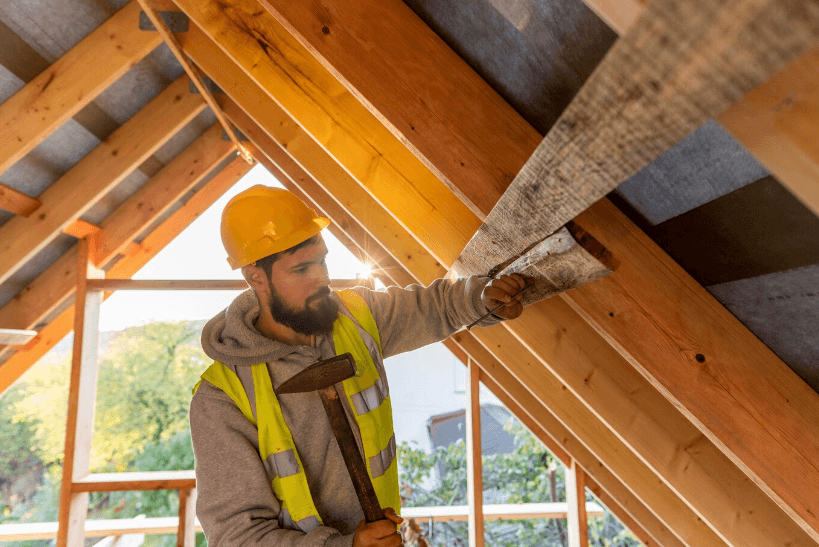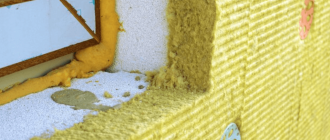Looking for a cost-effective and energy-efficient solution to keep your home comfortable?
Consider installing attic foam insulation! With its incredible thermal performance and ease of installation, attic foam insulation is the ideal choice for homeowners looking to improve energy efficiency and reduce utility bills.
Here are the key advantages of attic foam insulation:
- Superior Insulation: Attic foam insulation provides superior thermal insulation, minimizing heat transfer and keeping your home cool in summer and warm in winter.
- Energy Savings: By reducing air leakage and heat loss, attic foam insulation can significantly lower your energy consumption and save you money on heating and cooling costs.
- Improved Indoor Air Quality: Attic foam insulation acts as an effective air barrier, preventing the entry of outdoor pollutants, allergens, and dust into your home.
- Noise Reduction: Attic foam insulation also offers excellent soundproofing properties, reducing noise transmission and creating a quieter and more peaceful living environment.
Ready to install attic foam insulation in your home?
Follow these simple steps:
- Clean and Prepare: Ensure your attic is clean and free of any debris. Remove any existing insulation if necessary.
- Measure and Cut: Measure the dimensions of your attic space and cut the foam insulation sheets to fit accordingly.
- Install Insulation: Place the foam insulation sheets on the attic floor, ensuring they are tightly fitted and cover the entire area.
- Seal and Secure: Use tape or adhesive to seal any gaps or joints between the foam insulation sheets. Secure them in place to prevent movement.
- Enjoy the Benefits: Once the attic foam insulation is installed, sit back, relax, and enjoy the improved comfort, energy savings, and enhanced indoor air quality.
Don’t miss out on the numerous benefits of attic foam insulation. Install it today and transform your home into a more energy-efficient and comfortable space!
Advantages of Attic Foam Insulation
Attic foam insulation offers numerous benefits for residential and commercial buildings. Here are some of the advantages of using foam insulation in your attic:
- Energy efficiency: Attic foam insulation provides excellent thermal insulation, helping to keep your home or building cool in the summer and warm in the winter. This reduces the need for constant heating or cooling, resulting in lower energy costs.
- Air sealing: Foam insulation has the ability to seal cracks and gaps in the attic, preventing air leaks that can lead to drafts and energy loss. This creates a more comfortable indoor environment and improves overall air quality by preventing the entry of dust, pollen, and other pollutants.
- Noise reduction: Attic foam insulation has sound-dampening properties, reducing the transmission of outside noise into your living or working space. This can create a quieter and more peaceful environment, especially in areas with high levels of noise pollution.
- Moisture resistance: Foam insulation is resistant to moisture, preventing the growth of mold and mildew in your attic. This helps to maintain a healthier indoor environment and protects the structural integrity of your building.
- Durability: Foam insulation is long-lasting and does not settle over time, providing a durable solution for your attic insulation needs. It does not require frequent maintenance or replacement, saving you time and money in the long run.
- Environmentally friendly: Foam insulation is eco-friendly, as it helps to reduce energy consumption and carbon emissions. It also reduces the need for using other insulation materials that may have a negative impact on the environment.
With its numerous benefits, attic foam insulation is a smart choice for homeowners and building owners looking to improve energy efficiency, comfort, and durability.
Energy Efficiency
Improving the energy efficiency of your home is crucial for reducing energy costs and promoting a more sustainable environment. One effective way to enhance energy efficiency is through the installation of attic foam insulation. Attic foam insulation offers numerous benefits that can greatly contribute to energy conservation and cost savings.
Reduced Energy Consumption
Attic foam insulation provides a barrier that prevents the escape of conditioned air from your home. By sealing any gaps and cracks, it minimizes the need for excessive heating or cooling. This leads to reduced energy consumption and lower utility bills.
Enhanced Insulation
Foam insulation has superior insulating properties compared to other types of insulation materials. It forms a continuous layer that effectively blocks heat transfer, providing excellent thermal resistance. With attic foam insulation, you can maintain a more stable and comfortable indoor temperature throughout the year.
Further Benefits:
- Prevents drafts and air infiltration
- Reduces noise pollution
- Prevents the growth of mold and mildew
- Increases the lifespan of HVAC systems
- Improves indoor air quality
Investing in attic foam insulation is a practical and long-term solution to improve the energy efficiency of your home. By reducing energy consumption and providing enhanced insulation, attic foam insulation not only saves you money but also contributes to a greener and more sustainable future.
Cost Savings
By installing attic foam insulation, you can enjoy significant cost savings in various ways:
1. Energy Efficiency: Attic foam insulation helps in creating a thermal barrier that traps the heat inside during cold winters and keeps the cool air inside during hot summers. As a result, your HVAC system doesn’t have to work as hard to maintain the desired temperature, resulting in reduced energy consumption and lower utility bills.
2. Reduced Heating and Cooling Costs: With proper installation of attic foam insulation, you can expect a significant reduction in your heating and cooling costs. By preventing air leaks and ensuring a consistent indoor temperature, you can minimize the strain on your heating and cooling systems.
3. Long-Term Savings: Attic foam insulation is a long-lasting solution that can provide savings for many years to come. Once installed, it requires minimal maintenance and can effectively retain its insulation properties for a long time.
4. Increased Home Value: Installing attic foam insulation improves your home’s energy efficiency, making it more attractive to potential homebuyers. A well-insulated attic can be a selling point and may increase your property’s value when it comes time to sell.
5. Environmentally Friendly: By reducing your energy consumption and carbon footprint, attic foam insulation benefits the environment. It helps in minimizing greenhouse gas emissions and promoting sustainable living.
Investing in attic foam insulation is a smart choice that can yield substantial cost savings over time. Not only will you enjoy a more comfortable living environment, but you will also contribute to a greener and more sustainable future.
Comfort Improvement
Improving the comfort of your home is one of the major benefits of installing attic foam insulation. Attic insulation helps to reduce the transfer of heat between the interior and exterior of your home, creating a more comfortable living environment.
The foam insulation provides a barrier against temperature extremes, keeping your home cooler in the summer and warmer in the winter. This thermal control helps to maintain a consistent and comfortable temperature throughout your home, so you can enjoy every room without the need for extra heating or cooling.
In addition to temperature regulation, attic foam insulation also helps to reduce noise transmission. The foam acts as a sound barrier, minimizing the sounds from the outside world, such as traffic or neighbors. This creates a quieter and more peaceful living space, promoting a sense of calm and relaxation.
Furthermore, attic foam insulation improves indoor air quality by preventing the infiltration of dust, pollen, and other allergens. This can be especially beneficial for individuals with allergies or respiratory conditions, providing a cleaner and healthier living environment.
With the added comfort and improved air quality, you and your family can fully enjoy your home without any discomfort or worries. Installing attic foam insulation is a smart investment that enhances the overall quality of your living space.
| Benefits of Attic Foam Insulation | Steps to Install Attic Foam Insulation |
|---|---|
| Improved comfort | Measure the attic space |
| Energy savings | Clean and prepare the area |
| Noise reduction | Install the foam insulation |
| Enhanced air quality | Ensure proper ventilation |
| Increased resale value | Enjoy the benefits of insulation |
Noise Reduction
One of the additional benefits of attic foam insulation is noise reduction. Attics are often a source of unwanted noise from outside, such as traffic, airplanes, or neighbors. Installing attic foam insulation can help to reduce the noise that enters your home, creating a quieter and more peaceful living environment.
Attic foam insulation acts as a barrier, absorbing and blocking sound waves from penetrating through your attic and into your home. The foam insulation material is designed to minimize the transfer of sound waves, reducing the noise levels inside your home significantly.
By reducing noise, attic foam insulation can provide a more comfortable and peaceful living space for you and your family. Whether you want to enjoy a peaceful night’s sleep or simply have a quieter home environment, attic foam insulation can help to create a serene and noise-free atmosphere.
Furthermore, the installation process of attic foam insulation is quick and efficient. Once installed, you can immediately start enjoying the benefits of noise reduction. With attic foam insulation, you can say goodbye to the distractions and disturbances caused by external noise and embrace a more tranquil living space.
Key advantages of attic foam insulation for noise reduction:
- Minimizes the transfer of sound waves
- Reduces noise levels from outside
- Creates a quieter and more peaceful living environment
- Improves sleep quality and overall well-being
- Provides a serene and noise-free atmosphere inside your home
Don’t let unwanted noise disrupt your daily life and peace of mind. Install attic foam insulation today and experience the benefits of noise reduction for yourself!
Moisture Control
Moisture control is an essential aspect of any attic insulation project. By choosing attic foam insulation, you can ensure effective moisture control, preventing the accumulation of moisture in your attic space. This is crucial as excessive moisture can lead to various issues such as mold and mildew growth, wood rot, and damage to your attic’s structural integrity.
Benefits of Moisture Control
The benefits of moisture control through attic foam insulation are many:
- Prevents Mold and Mildew Growth: Attic foam insulation creates a moisture barrier, preventing water vapor from entering your attic. This significantly reduces the chances of mold and mildew growth, promoting a healthy living environment.
- Protects Structural Integrity: Excessive moisture in your attic can lead to wood rot, compromising the structural integrity of your attic. Attic foam insulation helps minimize moisture levels, protecting the overall structural integrity of your attic space.
- Improves Energy Efficiency: When moisture is present in your attic, it can affect the efficiency of your insulation. Attic foam insulation effectively controls moisture, allowing your insulation to perform optimally and improve energy efficiency.
- Enhances Air Quality: Moisture in your attic can contribute to poor indoor air quality. Attic foam insulation reduces moisture levels, helping to maintain healthy air quality and preventing the spread of airborne contaminants.
Steps for Moisture Control with Attic Foam Insulation
To effectively control moisture in your attic using foam insulation, follow these steps:
- Clean and Prep: Start by cleaning your attic thoroughly, removing any debris or existing insulation. Ensure the attic is free from any moisture sources, such as leaks.
- Seal Air Leaks: Before installing foam insulation, seal any air leaks in your attic to prevent the entry of moisture-laden air. Pay attention to areas around vents, chimneys, and electrical penetrations.
- Install Attic Foam Insulation: Apply the attic foam insulation using the appropriate technique, ensuring complete coverage and a tight seal. Follow the manufacturer’s instructions for best results.
- Monitor Moisture Levels: Regularly monitor the moisture levels in your attic to ensure that they remain within acceptable limits. If moisture issues persist, consider further measures such as improving ventilation or addressing any underlying issues.
By implementing proper moisture control measures with attic foam insulation, you can maximize the effectiveness of your insulation and enjoy a well-protected and energy-efficient attic space.
Increase in Property Value
Installing attic foam insulation can significantly increase the value of your property. This insulation option offers a range of benefits that potential buyers find appealing, making your property more attractive in the housing market.
The benefits of attic foam insulation include:
- Energy Efficiency: Attic foam insulation creates an effective thermal barrier, preventing air leakage and keeping your home well-insulated. This leads to reduced energy consumption and lower utility bills, which is highly desirable for buyers looking for energy-efficient homes.
- Improved Comfort: With attic foam insulation, your home’s indoor temperature remains consistent throughout the year. It prevents heat loss during winter and heat gain during summer, creating a comfortable living environment.
- Noise Reduction: Attic foam insulation acts as a barrier for sound, reducing external noise and creating a quieter indoor atmosphere. This is particularly beneficial for properties located in busy or noisy areas.
- Mold and Moisture Prevention: Foam insulation provides a seamless barrier that blocks moisture from entering your attic space. This helps prevent the growth of mold and protects your property from potential damage.
By highlighting the advantages of attic foam insulation and its installation in your property, you can increase its overall value and attract potential buyers who prioritize energy efficiency, comfort, and a well-insulated home.
Steps to Install Attic Foam Insulation
Installing attic foam insulation is a cost-effective and efficient way to improve the energy efficiency of your home. With attic foam insulation, you can enjoy a range of benefits such as reduced energy bills, improved indoor air quality, and increased comfort.
Preparation
- Clear the attic of any debris or obstructions.
- Seal any gaps or cracks in the attic to prevent air leakage.
- Wear appropriate safety gear, such as goggles and gloves, to protect yourself during the installation process.
Applying the Foam Insulation
- Start by mixing the foam insulation according to the manufacturer’s instructions.
- Use a foam sprayer or nozzle to apply the insulation evenly to the attic floor and walls.
- Ensure that the foam insulation covers all areas and creates a seamless barrier.
- Pay extra attention to areas around vents, pipes, and electrical wiring, as these are common sources of air leaks.
- Allow the foam insulation to dry and cure according to the manufacturer’s recommended time.
Post-Installation Check
- Inspect the attic to ensure that all areas are properly insulated.
- Check for any gaps or uneven application of the foam insulation.
- Fix any issues or missed areas by applying additional foam insulation as needed.
- Dispose of any leftover foam insulation and clean up the work area.
By following these steps, you can easily install attic foam insulation and start enjoying the benefits it provides. Remember to consult the manufacturer’s instructions and seek professional assistance if needed.
Assess the Attic
Before proceeding with the installation of attic foam insulation, it is important to assess the condition of your attic. This will help determine the amount of insulation needed and identify any existing problems that may affect its effectiveness.
1. Measure the Attic Space
Start by measuring the dimensions of your attic to determine its square footage. This will help calculate the amount of insulation required for adequate coverage. It’s important to cover the entire attic space to achieve maximum benefits.
2. Check for Existing Insulation
Inspect the attic for any existing insulation. Determine the type and condition of the insulation to evaluate whether it needs to be removed or if new insulation can be installed on top. It’s important to have a clean and even surface for the installation process.
3. Look for Air Leaks
Search for any air leaks or gaps in the attic that might affect the insulation’s performance. Common areas to check include around vents, openings for electrical wiring, and any gaps in the attic floor or walls. Properly sealing these leaks will enhance the effectiveness of the insulation and help maximize energy savings.
4. Evaluate Ventilation
Assess the attic’s ventilation system to ensure proper airflow. A well-ventilated attic promotes air circulation, prevents moisture buildup, and helps maintain a consistent temperature. It’s important to address any ventilation issues before installing the insulation to optimize its performance.
- Check for blocked or inadequate vents
- Ensure proper insulation around vents to prevent air leakage
- Consider installing additional ventilation if necessary
By thoroughly assessing your attic before installing foam insulation, you can ensure proper coverage and identify any underlying issues that may affect its performance. Taking the time to assess the attic will result in a more efficient insulation installation and maximize the benefits of attic foam insulation.
Clean and Prep the Attic
Before installing attic foam insulation, it is essential to thoroughly clean and prep the attic space. This step is crucial to ensure a successful and long-lasting insulation installation.
The first step is to remove any debris or objects from the attic. This includes old insulation, loose boards, and any other materials that may hinder the installation process. A clean and clear attic space will allow for a smooth and efficient installation.
Next, it is important to inspect the attic for any signs of mold, mildew, or water damage. If any issues are found, they must be remedied before proceeding with the insulation installation. This may involve repairing roof leaks, improving ventilation, or addressing any other moisture-related issues in the attic.
Once the attic is clean and free of any potential problems, it is time to prepare the surfaces for the foam insulation. This includes sealing any cracks, gaps, or holes in the attic walls, ceiling, and floor. This step is essential to create an airtight seal that will effectively prevent heat transfer and energy loss.
Using a high-quality foam insulation product, carefully apply the foam to the desired areas of the attic. Follow the manufacturer’s instructions for best results. It is important to ensure an even and consistent application of the foam insulation to maximize its benefits.
In summary, proper cleaning and prepping of the attic prior to foam insulation installation are critical for optimal performance. This includes removing debris, addressing any moisture issues, and sealing gaps and cracks. By taking these steps, you can create a well-prepared attic space that will enhance the effectiveness of the foam insulation and provide long-lasting benefits for your home.
Choose the Right Type of Attic Foam Insulation
When it comes to insulating your attic, choosing the right type of foam insulation is crucial. There are several options available, each with its own benefits and characteristics. Before making a decision, it’s important to understand the different types of attic foam insulation and their unique features.
Spray Foam Insulation
Spray foam insulation is a popular choice for attic insulation due to its ability to create a complete air barrier. It is applied as a liquid and expands to fill any gaps or cracks, providing excellent insulation and reducing energy loss. Spray foam insulation also helps to minimize the entry of moisture, preventing mold and mildew growth.
Rigid Foam Insulation
Rigid foam insulation is another effective option for attic insulation. It is made from polystyrene or polyurethane and is available in different thicknesses. Rigid foam insulation offers high R-values, providing excellent thermal resistance. It is also easy to install and can effectively reduce noise transmission.
Consider the specific needs of your attic when choosing between spray foam insulation and rigid foam insulation. If you have areas with hard-to-reach spaces or irregular shapes, spray foam insulation may be the better option. However, if you have a more straightforward attic layout, rigid foam insulation can be a cost-effective and efficient choice.
Before making a final decision, it’s always advised to consult with a professional insulation contractor who can assess your attic and recommend the best type of foam insulation for your specific needs. With the right attic foam insulation, you can enjoy improved energy efficiency, reduced utility bills, and a more comfortable living environment.
Measure and Cut Insulation Materials
One of the important steps in the attic foam insulation installation process is to measure and cut the insulation materials properly. This ensures a tight and effective seal, maximizing the benefits of using foam insulation in your attic.
Here are the steps to measure and cut insulation materials for your attic:
- Measure: Use a measuring tape to accurately measure the dimensions of the attic space where you will be installing the foam insulation. Start by measuring the length, width, and height of each section.
- Calculate: Once you have the measurements, calculate the total area of the attic space. This will help you determine the amount of foam insulation material you will need for the installation.
- Mark and Cut: Using a pencil or marker, mark the insulation material based on the measurements you have taken. Make sure to include any openings such as windows or vents in your calculations. Use a sharp utility knife or insulation cutter to cut the insulation material along the marked lines.
- Fit and Trim: After cutting the insulation material, carefully fit the pieces into the attic space, making sure they are snugly placed. If needed, trim the edges or corners of the insulation material to ensure a perfect fit.
- Repeat: Continue measuring, calculating, marking, cutting, fitting, and trimming the insulation materials until the entire attic space is covered.
Properly measuring and cutting the insulation materials is crucial for the successful installation of attic foam insulation. It allows for a precise and efficient coverage, preventing any gaps or air leaks that can compromise the insulation’s effectiveness. By following these steps, you can ensure that your attic is properly insulated, resulting in energy savings and improved comfort in your home.
Install and Secure the Insulation
Installing foam insulation in your attic is a great way to improve energy efficiency and reduce heating and cooling costs in your home. Here are the steps to properly install and secure the insulation:
- Prepare the area: Before starting the installation process, make sure the attic is clean and free of any debris or obstructions. Remove any existing insulation that may be present.
- Measure and cut the foam insulation: Measure the dimensions of the attic space and cut the foam insulation panels accordingly. Make sure to leave a small gap around the edges to allow for expansion.
- Secure the insulation: Start by placing the foam insulation panels along the walls of the attic, using adhesive or nails to secure them in place. Then, proceed to install the insulation on the floor and ceiling, making sure to cover all areas.
- Seal the gaps: Use spray foam or tape to seal any gaps or seams between the foam insulation panels. This will help to prevent air leakage and maximize the insulation’s effectiveness.
- Reinstall any fixtures: If you had to remove any fixtures or electrical wiring during the insulation installation, make sure to reinstall them properly and securely. Check for any loose connections or damaged wires before turning on the power.
- Inspect and clean up: Once the foam insulation is installed and secured, inspect the attic to ensure everything is in place and there are no visible gaps or openings. Clean up any debris or materials left behind during the installation process.
By following these steps, you can ensure a proper installation of attic foam insulation and enjoy the benefits of improved energy efficiency, increased comfort, and reduced energy costs in your home.
Q&A:
What are the advantages of attic foam insulation?
Attic foam insulation has several advantages. Firstly, it helps to improve energy efficiency by preventing the transfer of hot or cold air in and out of the attic. This can lead to lower heating and cooling costs. Secondly, attic foam insulation helps to reduce noise from outside sources, such as traffic or neighbors. Lastly, it can improve the overall comfort of your home by keeping the temperature more consistent throughout.
How does attic foam insulation help with energy efficiency?
Attic foam insulation helps with energy efficiency by creating a barrier that prevents the transfer of hot or cold air in and out of the attic. This barrier, often made of closed-cell foam, helps to seal any air leaks and provides an effective thermal insulation. By reducing the amount of air infiltration, attic foam insulation can help to keep the temperature inside the home more stable, reducing the need for heating or cooling and ultimately lowering energy costs.
Can attic foam insulation be installed by homeowners, or is professional installation required?
Attic foam insulation can be installed by homeowners, but it is recommended to consult a professional for assistance. The installation process can be complex, and it’s important to ensure that the insulation is applied correctly and evenly throughout the attic space. Professionals have the knowledge and experience to properly measure, mix, and apply the foam insulation, as well as to address any specific challenges or considerations unique to your home. Additionally, professional installation may be required to ensure the insulation meets local building codes and regulations.







